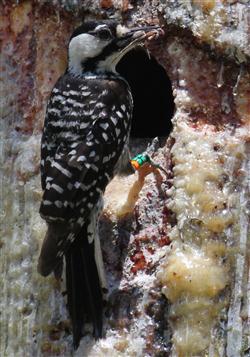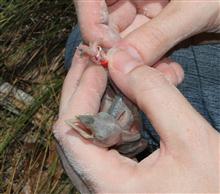Bumping along a sandy Forest Service road camouflaged with a thick layer of pine needles, I find myself under towering longleaf pines deep in the Croatan National Forest.
I am riding in a government pickup truck along with two National Forest Service wildlife biologists who have agreed to let me tag along and observe them banding endangered red-cockaded woodpecker chicks.
Supporter Spotlight
As we travel under the shade of the trees, I am consciously containing my excitement by casually asking a number of questions about this wood chipping bird. The enthusiasm of the biologists suggested that this didn’t seem to be just another ho-hum “got to band the birds” day. They seem to truly have a passion for the job that has them working on a beautiful Sunday afternoon.
Since the birds work all day and don’t get a day off, they could care less about the human weekend. Thus, the biologists must adjust to the schedule of the birds.
The truck came to a stop near a pine with an obvious woodpecker opening glittering with a fresh coat of oozing resin. As soon as I opened the door, I could hear a high-pitched squeaking sound and the confused look on my face caused Jason Forbes, biological technician, to say, “That’s the chicks.”
The sound reminded me of a wheel in serious need of oil. But in this case, the only thing that would stop this squeaking was more food. The demanding chicks were hungry and quite vocal about it. Right on cue, an adult red-cockaded arrived with a spider firmly in its bill.
Earlier this spring, Forbes and Rachelle Powell, a wildlife biologist, spent countless hours trekking through the Croatan searching for and documenting active red-cockaded cavity trees. These birds will hammer out a number of cavities in living longleaf pine trees to create roosting and nesting sites for their colony. Living trees are selected for cavity construction because the injured area will cause the tree to ooze a thick sticky film of resin around the cavity and down the trunk of the tree. The amount and duration of resin production of the longleaf is superior to other pines. This layer of fresh resin discourages predators such as black rat snakes from scaling the tree and entering the nest cavity in search of eggs or chicks.
Supporter Spotlight
 A red-cockaded woodpecker perches in its resin-coated longleaf pine nest. Photo credit: Sam Bland |
Drilling out a roosting or nesting cavity is tough work; it might take the adult birds over a year just to tunnel into the soft heartwood. The large older longleaf trees are ideal because the heartwood no longer produces resin and is usually easier to chip out due to decay. The cavity must also be free of the sticky resin that can easily trap the chicks and fowl the feathers of the adults. It is here in the heartwood that they will open up a chamber that will serve as a nesting site and eventual nursery for the chicks.
A colony of red-cockaded woodpeckers consists of a mating pair and the male offspring from previous years. Female offspring usually disperse to colonize other clusters. The older male offspring are called “helper birds” and they will help tend to the new chicks during the nesting period.
The area where the colony cavity trees are clustered is called, well, a cluster. Powell has documented around 100 of these clusters in the Croatan.
In mid-April, the female lays three to five eggs in the roosting cavity. After 10-12 days, the chicks will peck their way out of the eggs. This brief incubation period is one of the quickest of all birds, and it shows. The chicks do not pop out of the shell all cute and fuzzy; they are tiny, featherless, alien-looking creatures. Talk about falling out of the ugly tree; they fell all the way from the top. The scientific term for this type of development is called altricial.
These vulnerable chicks are born naked with their eyes still closed and they rely on their parents for warmth and food. The parents and helper birds will gather any insect, such as grubs, moths and spiders, which live among the scaly bark of the pine trees to fatten up the chicks. A little over three weeks later, the chicks are outfitted with a striking coat of feathers and are ready to fledge.
 USFWS Wildlife Biologist Rachelle Powell bands a red-cockaded woodpecker chick to track the movements of the local nests. Photo credit: Sam Bland |
The vast open old growth longleaf pine forests that once dominated much of the North Carolina coastal plain provided the specific habitat conditions necessary for the survival of the red-cockaded woodpecker. Beginning in colonial times, the longleaf was harvested to provide the products necessary to support a growing nation. The appetite for longleaf timber continued and now only a small fraction, three percent, of mature longleaf forest now exists.
The fate of the longleaf pine also holds the fate of the red-cockaded woodpecker. Throughout its range, it is estimated that red-cockades have declined 97 percent since the first European settlers came ashore.
This small bird was listed as endangered and received protection under the federal Endangered Species Act in 1973. In 1985, the U.S. Fish and Wildlife Service developed the Red-cockaded Woodpecker Recovery Plan to give this little bird a chance for survival.
Red-cockaded woodpeckers are picky. Not only do they need the longleaf pine forest, they need it just right. They require mature stands that are open and void of hardwood trees for both nesting and feeding. Usually, nature does a great job in creating this perfect habitat; however, sometimes nature needs a little help.
The Forest Service will conduct low-intensity controlled burns of the longleaf forests to prevent the domination of hardwood trees that would create a dense forest undesirable for nesting and feeding. In some areas, timber thinning practices are used to also achieve the same results. Since the construction of nesting and roosting cavities necessary for a successful colony might take years for the woodpeckers to hammer out, the forest service will install little bird condos, called artificial cavities, in mature longleaf trees. The biologists are also banding and monitoring the birds to establish population trends, which will provide scientific documentation that will hopefully someday lead to the delisting of the red-cockaded as an endangered species.
 Powell scales the tree to collect the chicks for banding. Photo credit: Sam Bland |
Back in the forest, Powell dons her climbing safety gear and scampers 25 feet up to a nesting cavity opening with the agility of a squirrel. Within seconds she lassoes a chick and gingerly pulls it out of the nest. A second chick is retrieved and Powell is back on the ground as Jason prepares the jewelry the chicks will soon wear.
Powell coats her hands with a layer of corn meal to prevent any resin she may have on her hands from sticking to the chicks. The two biologists quickly apply the bands to the squirming blobs of flesh and record the bird’s weight.
Banding the birds will help the biologists to identify individual birds to learn where they are and where they are going. This will allow them to concentrate habitat improvement practices along the corridors where the birds are active. The whole process took only a few minutes, and Powell quickly has the chicks back in the nest. It wasn’t long before the parents and helper birds were arriving with a room service delivery of spiders.
During 2012, Powell and Forbes documented 71 active red-cockaded clusters, of these, 70 were considered an active breeding group with a male and female. From these groups, 129 chicks were banded; the biologists are now out in the woods looking to see how many of these chicks fledged from the nest. As they survey the chicks, the biologists will also record other adult red-cockaded banding information. This year they learned that a female banded in the Croatan in 2008 is now successfully breeding in the Holly Shelter Game Lands in Pender County.
I stayed in the forest as the biologists headed off to another section of the Croatan National Forest to check on a few more cavity trees. As the sound of the truck faded away, the songs of the forest filled the air and the red-cockaded continued its quest for survival.







